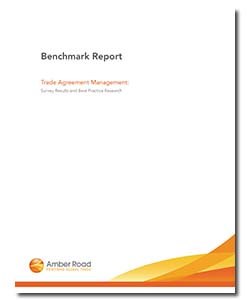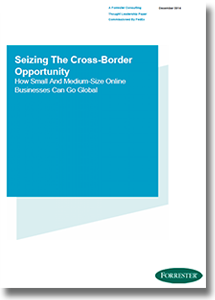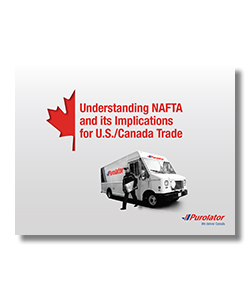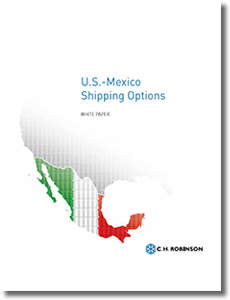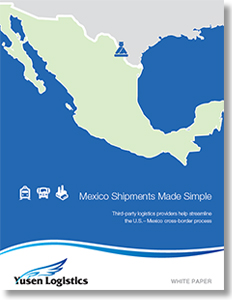Attention to Detail Essential in the Ever-Changing Cross-Border Regulations Maze

Ever-changing regulations are making it risky for U.S. companies engaged in cross-border trade endeavors, however, savvy shippers are paying better attention to the details and are finding solutions that save time, money and frustration.
Canadian Prime Minister Justin Trudeau says that when he meets with Canadian business owners and executives, he often asks whether they’re currently exporting to customers abroad.
It’s all part of an ongoing effort by his administration to encourage cross-border commerce.
However, every now and then he gets a response that speaks volumes about the relationship between his country and the United States.
“They’ll say: ‘No, we don’t sell internationally, we just sell to the United States,’” said Trudeau recently during a speech at the U.S. Chamber of Commerce, drawing chuckles from the audience.
“They don’t think of the United States as being international.”
Any veteran U.S. retailer or manufacturer doing business in either Canada or Mexico could have informed the new, dynamic Canadian Prime Minister differently.
American cross-border shipping - even to friendly North American allies such as Canada, where $750 billion in goods and services are traded annually - has never been more lucrative.
However, the fine print that makes up the constantly changing cross-border shipping regulations has never been more complicated.
“There are inherent compliance issues with cross-border trucking in North America,” says Beth Pride, president of transportation and logistics consulting firm BPE Global (pictured right).
“Companies have a significant compliance burden, ensuring that they accurately declare their product’s classification, valuation and country of origin.”
However, shrewd logisticians, armed with a good game plan and keen knowledge of how the cross-border shipping game works, can overcome these paperwork challenges.
According to Pride, whether in old-line heavy industry, such as automotive or equipment, or in critical sectors such as information technology and energy production, cross-border trade among the three North American Free Trade Agreement (NAFTA) nations (U.S., Canada and Mexico) is more crucial than ever as economies elsewhere are slowing.
NAFTA Freight Volumes Hit Bump
Trade among the three NAFTA nations has surged over the past 23 years, but there are bumps in the road, in part because the rising value of the U.S. dollar has made exports slightly less attractive.
Total value of cross-border freight carried fell 7.7% in January 2016 from a year earlier, totaling $82.4 billion in current dollars. This followed a report from a few days earlier, showing that there was a 7.2% drop in such movements in 2015 from 2014. Sharply declining crude oil prices are cited for those declines.
Still, experts say, cross-border freight will continue to produce significant freight volumes for truckers, which carry about two-thirds of total U.S.-NAFTA freight. From January 2015 to January 2016, the value of U.S.-Canada freight flows fell 12.7% to $42 billion, according to the DOT. During that same period, the value of U.S.-Mexico freight fell 1.8% to $40.5 billion.
Read: When it Comes to NAFTA Benefits, not all Products are Created Equally
The slowdown of China’s economy, for example, is a major driving factor in the growth of NAFTA trade. But “reshoring” or “near-shoring” of manufacturing is hardly new. It’s been going on since the 1960s, when U.S. manufacturers set up maquiladoras, or twin manufacturing sites, on both sides of the U.S.-Mexico border. Rising labor costs in China and elsewhere has accelerated the reshoring trend, experts say, putting even more pressure on our closest borders.
However, Rosemary Coates (pictured right), executive director of the Reshoring Institute and president of Blue Silk Consulting, recently told investors on a conference call that “reshoring can be justified if a manufacturer desires to insulate the company from the disruptions that come along with maintaining such an extended intercontinental supply chain.”
With that advice in mind, here’s what shippers need to know in order to take some of the time, cost, and frustration our of the cross-border puzzle.
Latest Cross-Border Trade Challenges
In addition to robust growth across the U.S.-Canada border, the U.S.-Mexico trade lane has been enjoying more than double-digit percentage growth for more than 10 years.
“It’s the greatest trade lane in the world,” says Carlos Cubias, vice president of the center of excellence for south border for UPS (pictured below) .
“My aim is to make shipping between the U.S. and Mexico like shipping between Arizona and California.”
But unlike shipping within the United States, there are obstacles and potential profit-killing delays at the border.
“There is a tremendous amount of backlog, and delays at the border are massive,” says Suzanne Richer, director of the trade advisory practice for software developer Amber Road (pictured below).
“At the border crossing in Laredo, Texas, at 7 a.m., for example, there’s already a line of more than 100 trucks waiting to cross the border, and these inspections are long and costly.”
To cut some corners on time, Richer advises U.S. shippers to participate in a number of expedited shipping clearance programs offered by governments on both sides.
These include Customs-Trade Partnership Against Terrorism (C-TPAT) and Nueva Esquema Empresa Certificate (NEEC), among others.
Shippers should also be aware of recent changes in new laws covering Country of Origin Labeling (COOL), she adds.
“Savvy companies have to understand that if you join NEEC and C-TPAT, you have to align the two programs to share information,” advises Richer.
“If you are in C-TPAT, but not validated in Mexico with NEEC, you may not get the expedited treatment unless you validate your NEEC registration.”
BPE’s Pride says that she often sees U.S. companies failing to correctly declare the country of origin of their products. “They presume that the country of origin of an item is the country that it’s exported from rather than the country where it was manufactured,” Pride says.
As a result, a company tends to list Canada, Mexico or the United States as country of origin on their North American cross-border shipment invoices that may result in them making false NAFTA claims.
If you or your supplier lists one of those NAFTA countries as the country of origin, your customs broker will most likely ask one of your employees to provide a NAFTA certificate of origin.
“That employee will provide NAFTA certification without appropriate analysis of the rules of origin, thinking that the document is required to clear the goods through Customs,” Pride explains.
“In many cases, the employee doesn’t realize that this certification obligates their company to comply with the terms of NAFTA and is not a requirement for clearance.”
Pride adds that companies must take three critical steps when making NAFTA claims: First, determine that the products are eligible for NAFTA; second, qualify the products for NAFTA; and third, certify or obtain certification for the items for NAFTA.
“Far too many companies fail to do all three steps, and this results in additional compliance obligations and increased risk - it’s a double edged sword,” she adds.
Running an effective NAFTA program brings administrative burden and cost, and making false NAFTA claims exposes your brand and carries “significant financial risks,” says Pride.
“Claiming NAFTA should be just like any solid business decision. You should know your bottom line before signing any NAFTA certificates of origin.”
Connecting the Dots
Cross-border compliance is complicated, and “it’s definitely easy to overlook things,” says UPS’ Cubias. In fact, experts across transportation are advising U.S. shippers that they should be using a reliable third-party or proven cross-border transport partner.
“One of the main challenges is the discrepancy between border processes and systems,” says Brad Jacobs, CEO of XPO Logistics (pictured below).
“The border along Canada is more automated than across Mexico, but it’s still important to have a good working relationship with customs brokers so your shipments clear with no delays.”
Hello FedEx CrossBorder, Goodbye Bongo
FedEx Trade Networks, the FedEx Corp. unit charged with international freight forwarding, has re-launched what it had called its Bongo International freight forwarding unit. It is now marketed as FedEx CrossBorder as a way to attract more cross-border shippers - especially in e-commerce.
The change comes when global e-commerce is enjoying double-digit percentage growth. Total online buying now exceeds $1 trillion in annual sales. According to FedEx, a big part of CrossBorder’s strategy for e-tailers is regulatory compliance, how to navigate the fine print of cross-border laws, and the ability to accept currencies from more than 80 nations.
FedEx division vice president Chip Hull says that only one in three U.S.-based global e-commerce Websites accept foreign currencies.“Research tells us that customers are more likely to abandon shopping carts that only show U.S. pricing,” he says.
Read: FedEx Introduces Global E-Commerce Solutions under FedEx CrossBorder
Truck size and weights are not uniform among the three NAFTA countries, with Mexico allowing heavier trucks than the typical 80,000-pound trucks found in America. “Some importers into Mexico add more weight, but that means that U.S.-bound trailers have to be transloaded, which adds costs and increases time,” says Jacobs.
“We don’t allow such overloading - that helps keep rates down and claims low.”
Trucking safety regulations are also different between U.S. and Mexico. “Drivers’ scores in Mexico often don’t stand up to U.S. scrutiny, and that makes it challenging for drivers crossing into this country,” Jacobs explains.
“We maintain a network of Mexican carriers that meet U.S. regulations, and we don’t send U.S. drivers into Mexico, and vice versa.”
Still, says Jacobs, Mexico “represents a strategic market for us.” That’s because the Mexican economy offers a buffer in case of a U.S. financial downturn, and also because the Mexican government has committed billions of dollars to improved infrastructure.
Cross-Border Success Exists
Experts say that while using trusted partners for cross-border shipments is great, there’s no substitute for comprehensive, in-house understanding of the myriad, ever-changing regulations covering your shipments.
“The majority of companies have not undertaken sufficient training to understand border crossing complexity,” says Richer. “Customs brokers and carriers play important roles, but the knowledge a company has should not be so limited that they can’t see or understand the risks. At the end of the day, importers and exporters should be just as savvy about these issues rather than just relying on one source for this information.”
Of course, besides having the best in-house knowledge on cross-border issues, shippers find it most advantageous to partner with a carrier or service provider that knows its way around the complexities that can arise at the border.
There are many examples of successful cross-border strategies, all tailor maid to a particular shipper’s needs. UPS’ Cubias shares an example of a “big three” U.S. automobile manufacturer that used a transmission supplier based in Mexico. That supplier was unable to meet demands from the OEM and often had to use expensive airfreight deliveries to keep up with surging demand levels.
According to Cubias, UPS was able to offer the OEM a choice: The transmission supplier could either utilize an expedited truckload service from the interior of Mexico to the Southwest U.S. enabling two-day service. Or it could use its standard six-day truck service. However, UPS began a blended service that included a four-day ground solution.
“They usually stick with standard,” says Cubias. “But recently, there were floods in the Southwest U.S. that hurt the ability to move in standard time. So we can move it to a two-day window, which has proven a very cost-effective way to manage their inventory.”
So whether the solution comes from a tailored logistics program devised by a reliable third party, or is designed in-house with the expertise from a manufacturer’s own supply chain team, the answer often comes from attention to detail in the ever-changing cross-border maze.
“No matter how you do it, it’s all about connectivity,” adds XPO’s Jacobs.
Related: UPS Expands U.S.-Mexico Cross-Border Services

Cross-Border White Papers
Trade Agreement Management: Survey Results and Best Practice Research
Companies should be aware of a number of critical considerations when implementing an FTA program. First, is an understanding of how to use trade agreements most efficiently and competitively. Download Now!
Seizing The Cross-Border Opportunity
In conducting an in-depth survey of 9,006 global online shoppers, as well as interviews with 34 SMEs with crossborder eCommerce operations in 17 countries and territories, Forrester found that cross-border shoppers have consistent and specific needs centered on seller reputation and logistics as they purchase overseas. Download Now!
Understanding NAFTA and its Implications for U.S./Canada Trade
It’s been 20 years since the North American Free Trade Agreement (NAFTA) took effect, but debate continues with regard to its net benefit to the U.S., Canadian, and Mexican economies. The agreement created the world’s largest free trade zone Download Now!
U.S.-Mexico Shipping Options
Understanding what can happen at the U.S.-Mexico border with your truckload shipments could impact the decisions you make - and whether or not you will actually get what you pay for. Download Now!
Mexico Shipments Made Simple
Today’s shippers are sending more freight across the Mexico border as they expand their operations and customer base in Mexico, and third-party logistics providers can help them navigate cross-border challenges. Download Now!
Article Topics
Amber Road News & Resources
Logistics Platforms: Ways Companies Can Win In the Digital Era Ethical Sourcing – The Business Imperative (and Advantage) How Rules of Origin Really Do Make a Difference for Sourcing Practices E2open’s acquisition of Amber Road is a done deal E2open Completes Acquisition of Amber Road Bridging the Data Gap Between Sourcing and Logistics Medical Technologies Company Remedies Complex Compliance Operations More Amber RoadLatest in Supply Chain
TIm Cook Says Apple Plans to Increase Investments in Vietnam Amazon Logistics’ Growth Shakes Up Shipping Industry in 2023 Spotlight Startup: Cart.com is Reimagining Logistics Walmart and Swisslog Expand Partnership with New Texas Facility Nissan Channels Tesla With Its Latest Manufacturing Process Taking Stock of Today’s Robotics Market and What the Future Holds U.S. Manufacturing Gains Momentum After Another Strong Month More Supply Chain






